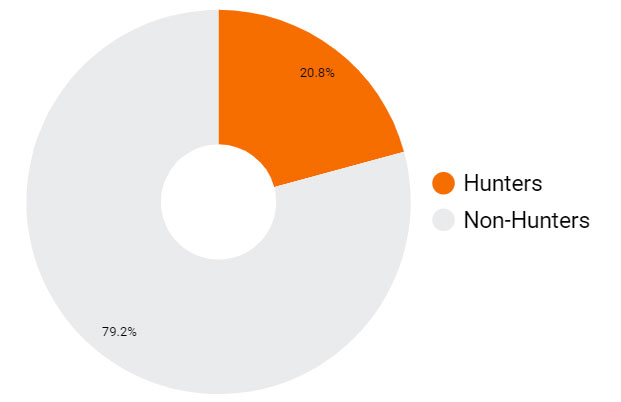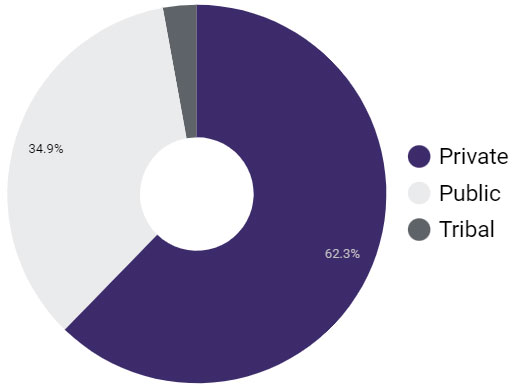Hunting in Montana
Montana Hunting at Glance
Montana is a big state with a lot of public land and plenty of opportunities for hunting. The state is home to an abundance of different game species, both big and small. Black bears, mule deer, white-tailed deer, pronghorn antelope, Rocky Mountain elk, Shiras moose, mountain goats, mountain lions, bighorn sheep, wolves, and bison are among the huntable species in Montana. In most of the state, upland birds and waterfowl can also be hunted.
The continental divide runs down the middle of Montana, dividing it into distinct eastern and western areas. The west is home to the majority of the mountain ranges (at least 100). Prairie accounts for about 60% of the state, but there are a number of isolated peaks and ridgelines that break up the prairie vista.
Montana ranks #3 in the nation for hunting license per capita and has a strong hunting culture with over 20.8% of the population classified as registered hunters.
Key Insights
-
- The Montana Department of Natural Resources (DNR) is a good resource for accurate information on hunting seasons and requirements in the state.
- Small game species popular for hunting in Montana include pheasants, grouse, chukar, quail, and partridge.
- Big game species popular for hunting in Montana include white-tailed deer, mule deer, elk, moose, and bighorn sheep.
- Hunters can access millions of acres of private land in addition to public land for hunting.
- Outfitters and guides can help hunters plan and execute a successful hunt in Montana.
Table of Contents
| Population: | 1,084,225 |
|---|---|
| Hunters | 225,519 |
| Hunter % | 20.80% |
| Hunters Rank | 3 |


| Acres | % | Rank | |
|---|---|---|---|
| Total | 93,155,800 | ||
| Huntable Public | 30,065,000 | 32.27% | 11 |
| Private Land | 57,999,380 | 62.26% | 39 |
| Tribal Land | 2,683,200 | 2.88% | 8 |
Montana ranks #39 for the percentage of private land vs total acres and number 8 in terms of acres of tribal land.
Montana Hunting Seasons & Requirements
For the most accurate information on Montana Hunting Seasons, along with the state’s requirements for tag and bag limits, it’s a good idea to check with the Montana DNR. We’ve provided their contact information below, along with links to helpful resources, including licensing.
Montana DNR
1420 East Sixth Avenue
P.O. Box 200701
Helena, MT 59620-0701
- (406) 444-2535
Popular Game to Hunt in Montana
Montana is a great state for hunting, with a variety of game species and good management practices in place. The state has a variety of landscapes, from prairies to mountains and is great for both big game and small game hunting.
Small Game Hunting in Montana
Among small game hunters in Montana, pheasants are the most popular quarry, followed by grouse, chukar, quail, and partridge. All five species are found throughout the state, although they are more common in certain areas. Pheasants, for example, are often found in agricultural fields or near water sources, while grouse tend to prefer heavily forested areas. Chukar typically inhabit rocky hillsides, and quail typically stay near brushy cover. Partridge can be found in a variety of habitats but are especially common in open grasslands. Regardless of where they are found, all five species provide challenging and enjoyable hunting opportunities for small game enthusiasts in Montana.
Big Game Hunting in Montana
There are many different types of big game to choose from in Montana. The most popular species to hunt are white-tailed deer, mule deer, elk, moose, and bighorn sheep. Each species has its own unique challenges, and all provide a rewarding hunting experience. White-tailed deer are the most abundant big game species in Montana, and they can be found in nearly every corner of the state. Mule deer are slightly less populous, but they offer a more challenging hunt due to their wariness of humans. Elk are another popular choice for hunters, and they can be found in both forested and open areas. Moose are the largest big game animals in Montana, and they are a prized trophy for any hunter. Lastly, bighorn sheep are the most difficult to hunt due to their remote location and elusive nature. However, these five species are all popular choices for hunters in Montana and provide a unique and rewarding hunting experience.
The hassle free way to monetize your acreage.
Where are the Best Areas to Hunt in Montana
Montana offers great hunting opportunities across the state, both on public and private land. We’ve included some of the best areas for public hunting below and as we have access we’ll be adding more private land too.
Unlock the Great Outdoors
Popular Public Hunting Land in Montana
Montana is well-known for its wilderness areas and abundance of wildlife, making it a popular destination for hunters. There are many different types of public land available for hunting in Montana, from national forests to national wildlife refuges.
Bighorn Canyon National Recreation Area is located in south-central Montana and offers a variety of habitats to hunt, including canyonlands, grasslands, and forests. The Charles M. Russell National Wildlife Refuge is one of the largest refuges in the lower 48 states and is home to a variety of game species, including deer, elk, and bighorn sheep. Flathead National Forest is located in northwest Montana and offers over 2 million acres of wilderness to explore. Helena-Lewis and Clark National Forest is located in central Montana and includes the Bob Marshall Wilderness area – one of the largest wilderness areas in the United States. Kootenai National Forest is located in northwest Montana and includes over 3 million acres of forest land.
1. Bighorn Canyon National Recreation Area
2. Charles M. Russell National Wildlife Refuge
3. Flathead National Forest
4. Helena-Lewis and Clark National Forest
5. Kootenai National Forest
Hunting Private Land in Montana
Since the majority of Montana is private land getting access for hunting can be very appealing. When you hunt private land, it’s not only less crowded, the animals also tend to be less skittish and this means you’ll have a better day out in the field. Traditionally, accessing private land for hunting has been complicated and expensive. You either needed to join a club, hire a guide, or start knocking on doors.
Fortunately Wing It is simplifying this for hunters and outdoor enthusiasts of all types. We’re adding new land every day and if we have some in your area, you’ll see some options great below.